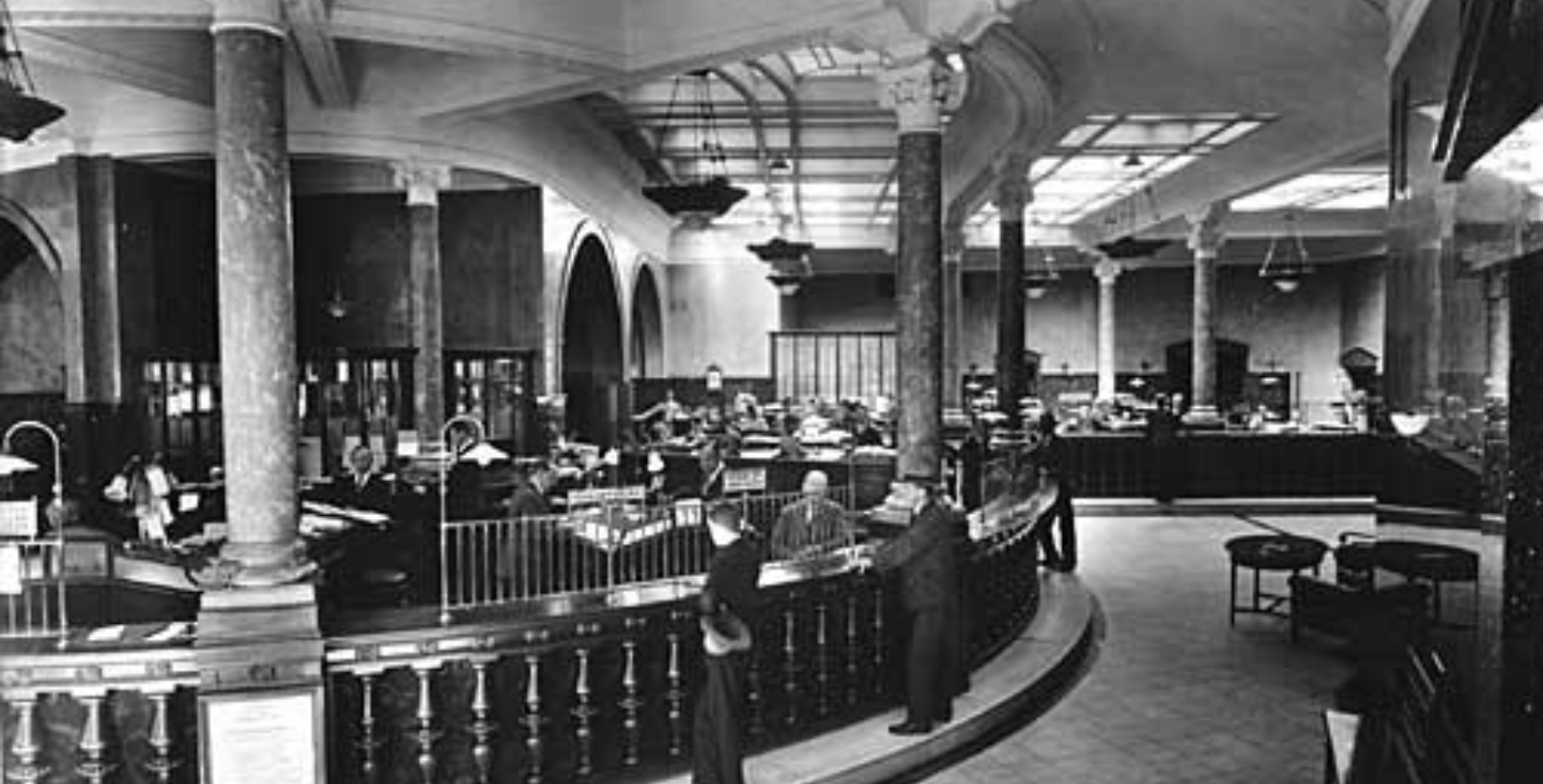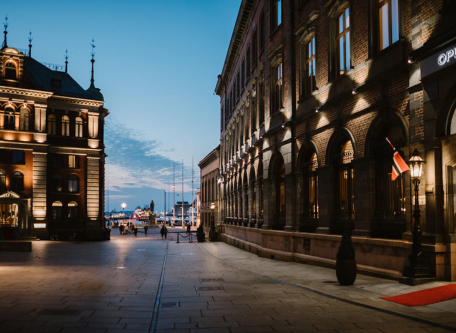Receive for Free - Discover & Explore eNewsletter monthly with advance notice of special offers, packages, and insider savings from 10% - 30% off Best Available Rates at selected hotels.
history
Discover Opus XVI, which was once the headquarters for Bergen’s largest bank, Bergens Kreditbank.
Located in the heart of historic Bergen, Norway, the building that is currently home to Opus XVI was originally constructed to house the city’s largest financial institution, the Bergens Kreditbank. In the late 19th century, Bergens Kreditbank decided it needed a large enough facility to facilitate its burgeoning business operations and began exploring possible locations to accommodate a new headquarters. Its managerial team eventually selected a lot along the gorgeous Vågsallmenningen to be the site of its prospective building. The bank then hired Herman Major Schirmer to spearhead the design, who chose a variety of eclectic architectural influences to ultimately craft its breathtaking appearance. Among the most distinctive traits that Schirmer created involved the use of gorgeous red brick that constituted the exterior façade. He continued to produce many fantastic architectural features throughout the building’s interior, too, such as his installation of heavy granite walls and ornate marble columns. When the building finally debuted officially as the new home of the Bergens Kreditbank in 1876, it immediately became one of Bergen’s most celebrated local landmarks. In fact, locals from across the city informally referred to the building as the “Banco Rotto” due to its impressive appearance.
The bank subsequently operated from inside Schirmer’s iconic structure over the next several decades. Indeed, generations of customers conducted business from within the building, including the great Norwegian composer Edvard Grieg, the inspiration behind Opus XVI. The continued prosperity even enabled the managers of the Bergens Kreditbank to institute numerous renovations, culminating with architect Schak Bull’s extension in 1918. (Interestingly, Bull had also worked on Greig’s residence, the “Troldhaugen.”) But the continued success of the Bergens Kreditbank caused it to eventually outgrow the building by the end of the 20th century. Its fate left uncertain, the erstwhile bank was saved when Alexander and Britt Marie Grieg purchased it during the 2010s. Relatives of Edvard Greig, the two yearned to resurrect the fascinating character that had originally defined the space back during the composer’s lifetime. They determined the best recourse was to transform the structure into a luxurious boutique hotel that would celebrate the rich heritage of the location. Taking months of hard work to complete, the building finally debuted as the Opus XVI before great acclaim. (The name is an homage to Edvard Greig’s celebrated Piano Concerto in A minor, Op. 16, as well as to the hotel’s street address, Vågsallmenningen 16). Opus XVI has since emerged as one of the most popular destinations in downtown Bergen, offering nothing but the best in modern comfort.
-
About the Location +
Opus XVI is located in the heart of downtown Bergen, Norway. A dominant presence in the region, Bergen’s history dates back nearly a thousand years. In 1066, a massive Viking fleet of nearly 300 ships anchored off the coast of northern England. Leading the host was the legendary Norwegian king Harald Hardrada, who had been inspired to seize the English throne following the death of King Edward the Confessor. Nevertheless, Hardrada’s ambitious plan fell apart when the English thoroughly routed his army at the Battle of Stamford Bridge. The king himself was even slain at some point during the fight. Disheartened, the surviving Norwegians sailed home under the banner of Hardrada’s son, Olaf Kyrre. Now ruling Norway as King Olaf III, Kyrre solemnly guided the kingdom through some of the most prosperous years in its history. One of the major projects that he undertook was the development of Bergen in western Norway. (The city’s original name was actually “Bjørgvin.”) Located only a few miles from the coast of the North Sea, Bergen rapidly emerged as one of the most significant cultural centers in Norway. Indeed, Kyrre constructed many important municipal buildings in the city, such as a sprawling estate that eventually evolved into the imposing Bergenhus fortress.
King Olaf’s city only continued to grow in significance, as it obtained the status of royal capital by the height of the Middle Ages. In fact, numerous royal coronations took place in Bergen, with the first one transpiring during the mid-12th century. Although Bergen’s political status was diminished greatly after King Haakon V relocated the capital to Oslo, the city nonetheless remained an important economic center for generations. The city’s proximity to the North Sea made it an active seaport for many centuries thereafter, especially among the merchants of the Hanseatic League. A powerful commerce guild located within several German cities, the organization traded widely throughout all of Europe until the onset of the Renaissance in the 16th century. Like many other seaports on the continent, Bergen became heavily affected by the economic activity of the Hanseatic League. Some German businessmen affiliated with the group eventually settled in Bergen permanently and developed a trading post near the city’s wharves. Called the “Bryggen,” this facility quickly grew into one of the League’s four main outposts known as a “kontor.” Driving this wealth was the export of dried cod, which the German merchants held a monopoly over for some time.
Bergen endured as a bustling seaport even after the Hanseatic League’s reach across the continent eventually declined. In fact, its strong economy even made it the target of pirates, such as the notorious Victual Brothers. Foreign nations attacked Bergen as well, including the English, who assaulted the port during the Second Anglo-Dutch War. (The English were trying to corner a Dutch merchant fleet that had anchored in Bergen.) Nevertheless, Bergen remained an incredibly prosperous community despite those periodic tumultuous moments—a status that it continues to enjoy today. Its impressive history has also made Bergen a favorite destination for countless cultural heritage travelers. Among the many fascinating institutions and attractions that have allured tourists from around the globe include the Norges Fiskerimuseum, the Bergens Sjøfartsmuseum, and the Hanseatic Museum and Schøtstuene. It is home to many outstanding historical landmarks, too, such as the once mighty Bergenhus fortress. One of its historical landmarks, the Bryygen, is even recognized as a UNESCO World Heritage Site by the United Nations. Come stay at Opus XVI and experience the heritage of this fantastic city firsthand!
-
About the Architecture +
When Herman Major Schirmer first designed the building that would eventually house Opus XVI, he chose elements of Italian Renaissance Revival architecture to craft its appearance. Italian Renaissance Revival architecture itself is a subset of a much large group of styles known simply as “Renaissance Revival.” Renaissance Revival architecture—sometimes referred to as "Neo-Renaissance”—is a group of architecture revival styles that date back to the 19th century. Neither Grecian nor Gothic in their appearance, Renaissance Revival-style architecture drew inspiration from a wide range of structural motifs found throughout Early Modern Western Europe. Architects in France and Italy were the first to embrace the artistic movement, who saw the architectural forms of the European Renaissance as an opportunity to reinvigorate a sense of civic pride throughout their communities. Those intellectuals incorporated the colonnades and low-pitched roofs of Renaissance-era buildings, with the characteristics of Mannerist and Baroque-themed architecture. Perhaps the greatest structural component to a Renaissance Revival-style building involved the installation of a grand staircase in a vein similar to those located at the Château de Blois and the Château de Chambord. This particular feature served as a central focal point for the design, often directing guests to a magnificent lobby or exterior courtyard. However, the nebulous nature of Renaissance Revival architecture meant that its appearance varied widely across Europe. Historians thus often find it difficult to provide a specific definition for the architectural movement.


























